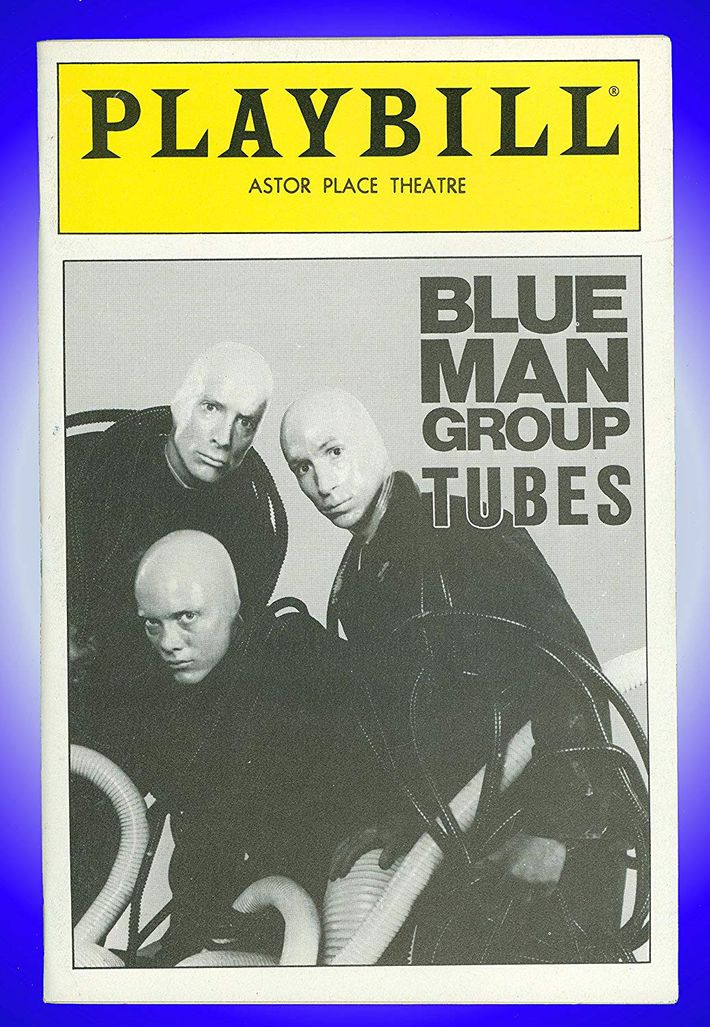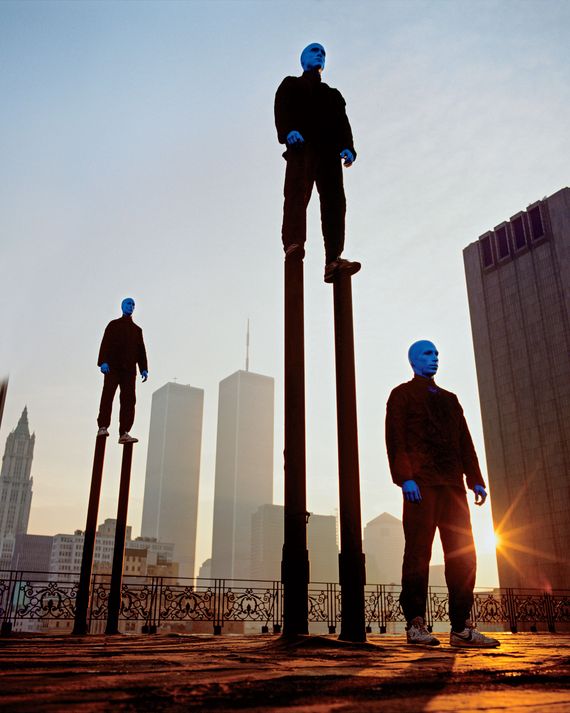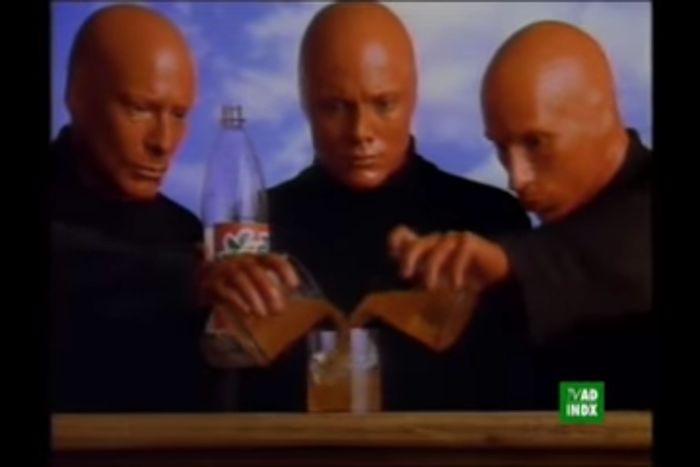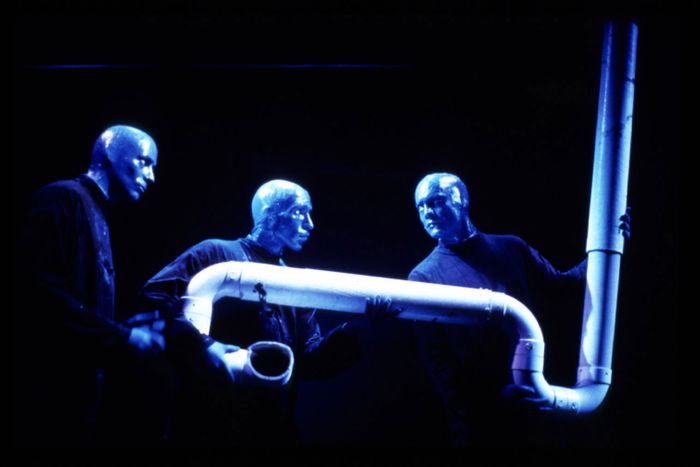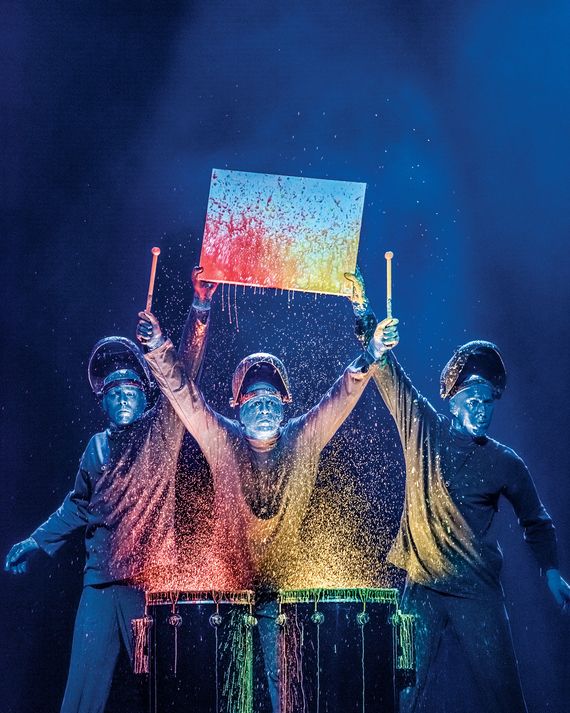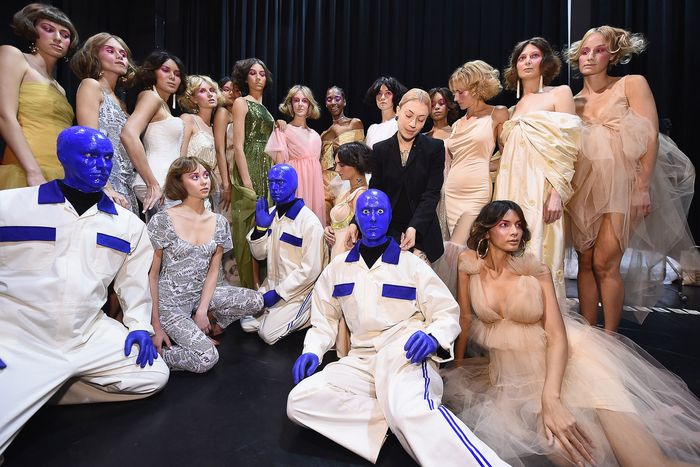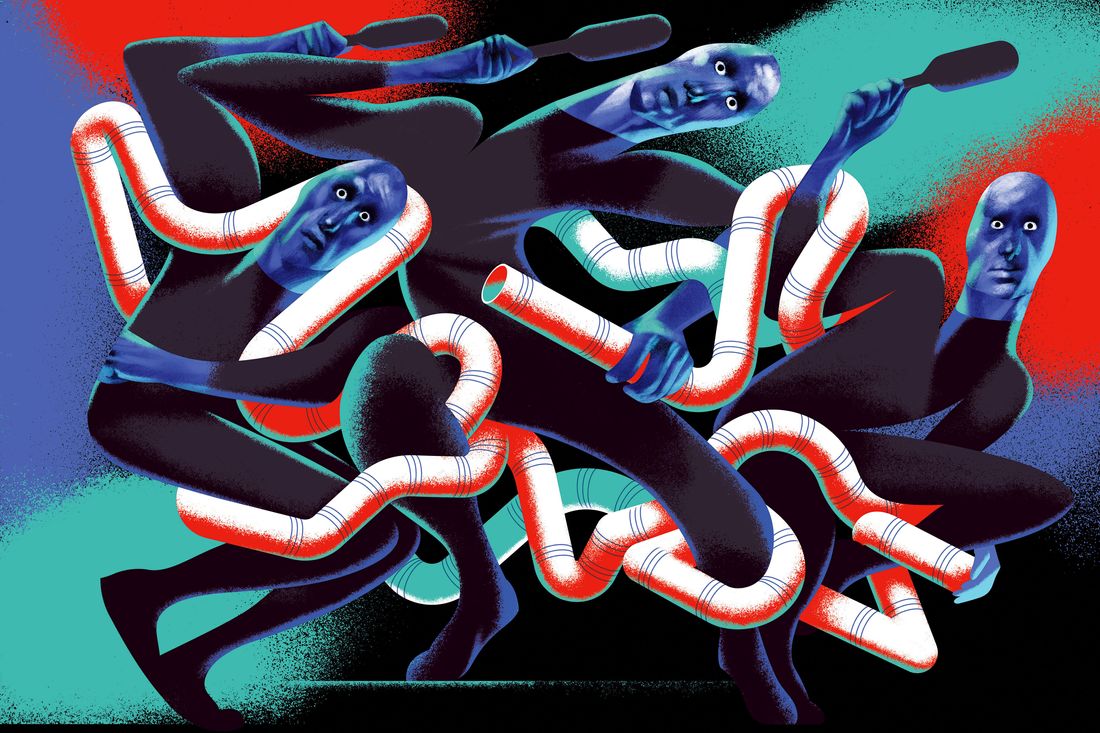
On May 21, 1988, eight people carried a coffin into Central Park to conduct a “funeral for the ’80s.” Inside it were items meant to represent the culture of the decade: a Rambo doll, tiny figures wearing suits (yuppies), bags of a white substance resembling crack. The participants, most of whom had painted their skin blue, piled the objects into a metal drum along with some flash paper, which they lit on fire. They called themselves the Blue Man Group.
Within months, the group of Blue Men had been winnowed down to three: Chris Wink, Matt Goldman, and Phil Stanton. Over the next few years, with input from a circle of art-school kids and musicians, they would bring their constantly evolving act to many spots around the city — they played with vaudeville at King Tut’s Wah Wah Hut, experimented with flying paint at La MaMa, and eventually landed at Astor Place Theatre. The three characters were general outsiders, unfamiliar with our customs and unable to speak but endlessly curious and eager to connect; they also caught a heroic number of food items in their mouths. “The word on the street was we were nuts,” says Larry Heinemann, who played with the group on instruments including the Chapman Stick.
There have since been shows in Boston, Chicago (where Fred Armisen was a drummer with the Blue Men early in his career), Las Vegas, Orlando, and beyond, as well as commercial campaigns featuring the original trio and tours with Moby, David Bowie, and Busta Rhymes. This past November, the Astor Place show marked its 30th year — one of the most successful Off Broadway runs of all time.
That this undeniably unusual show found an audience when it launched — during the rise of rave culture and a few years after Burning Man debuted on Baker Beach — made a certain kind of sense for the era. But its lasting success has surprised no one more than the founders themselves. “From the beginning, we weren’t just trying to be pure — to make art and gaze at our navels,” says Wink. “But it’s not like we expected to get as far as we did. It would have been insane to think that.”
.
Going Blue
Wink and Goldman met while attending Fieldston School in the Bronx. In their 20s, they shared an apartment on the Upper West Side. Goldman was a software producer; Wink was a trend forecaster, drummer, and caterer at Glorious Foods — which is where he met Stanton, an aspiring actor.
Juliet Lofaro, props coordinator, 1991–94: I was living with Chris and Matt. Chris grew up in the apartment, and one day I found a book he made as a kid called My Blue World, with pictures of a blue man.
Larry Heinemann, original Chapman Stick player: As long as I knew Chris, the idea was in his head — Wouldn’t it be cool to see a bunch of blue men walking down the street?
Chris Wink, co-founder: It was just this idea of getting blue and walking around seeing what happened as a social experiment. It wasn’t really fleshed out.
Heinemann: Around 1986, Chris and Matt started holding salons. We were all charged with sharing something — a song, a photo, an idea. A theme was our disappointment with what early-’80s music had morphed into.
Wink: Punk had died, Studio 54 was closed, and it was the Reagan ’80s. That was when the term yuppie started. MTV came along and turned all these cool bands into singing monkeys. For us, the decade didn’t seem cool.
Heinemann: We thought performance art would be the next cultural tidal wave.
Matt Goldman, co-founder: We wanted to build a movement of people who wanted to be creative even if it was in ways that didn’t fit society’s definition.
Wink: We used our apartment as a home base — we got rid of all the furniture.
Heinemann: At the salons, the Blue Man would come up — maybe this could be something? At one, Chris smeared blue makeup on his head. We were like, “That’s cool, but your hair looks weird.” The next salon, he had a bald cap.
Wink: It’s not like we were saying, “What’s the character’s backstory? Should he be green or blue?” It was more mysterious than that. We picked blue because it felt right.
Goldman: I have a visceral recollection of the first time the three of us got bald and blue. We went on the roof and just sort of looked at each other, realizing this character was special.
Heinemann: Then it became, “What are we going to do with this?”
Lofaro: The funeral for the ’80s came about in the living room.
Wink: We figured if we had a bold statement — “The ’80s are over” — and if MTV covered it, it’d be true. We wrote a press release and invited Kurt Loder.
Heinemann: Kurt actually covered it, which was crazy for our first thing.
Goldman: He made it seem like if you missed this thing, you were a loser.
.
An Open-ended Run
A few months later, the group organized another “happening,” as they called it, outside the Copacabana Club on East 60th Street. They used velvet ropes to set up a ten-by-ten-foot square on the sidewalk — which they called Club Nowhere — and invited anyone who wanted to party inside for free. “Club Nowhere was the last of the verbal Blue Man events,” Heinemann says. “Around then, we discussed how the character doesn’t talk.” They soon began developing a series of short performance pieces inspired by sources as varied as fractal geometry and the Japanese drumming troupe Kodo.
In 1991, they staged a production called Tubes at the Off–Off Broadway theater La MaMa. During one segment, the Blue Men wore goo-squirting nozzles (people in the front rows were given protective plastic wrap to wear). Tubes began an open-ended run at Astor Place Theatre in November 1991. The show had more music, new segments, and, for the first time, an arc, which moved from alienation (it started with the Blue Men staring down the audience) to community (the finale involved audience members unfurling rolls of crêpe paper over their heads that left everyone covered in a type of connective tissue). The Blue Men drummed, accompanied by a three-person band; they jumped into the audience to dance; and for every show, they invited someone onstage to eat a Twinkie. They also installed tubes around the theater that traveled from the basement (which served as the backstage space) up to the seating area. Before and during shows, performers and crew members used the tubes to speak to the audience. Transitioning a fly-by-the-seat-of-your-pants operation to the more formal demands of an Off Broadway production presented some difficulties.
Kevin Cunningham, production stage manager, 1991–92: During rehearsals, the cable snapped for a big flying prop — a box full of heavy laminated cards — and it fell right behind us. There were lots of Spinal Tap moments like that.
Wink: We’d learned that if you put the blue makeup on your hands, everything you touched would get blue and slippery. So we got white surgical gloves and had someone dye them. Eventually, somebody called the glove company and said, “Hey, can you dye them for us?” They said, “Yeah.” We couldn’t believe it.
Cunningham: Each show, they would use about 32 ounces of cream cheese, 80 pounds of Jell-O, two cases of bananas, and 15 gallons of water-based tempera paint. The plywood deck of the stage got permeated with organic matter. One night, I called the first cue and the lights came up but I couldn’t see anybody onstage — there was this sort of black fog. What we were looking at was a blossoming of fruit flies that all hatched at the same time.
Ian Pai, original drummer: It took us a long time to learn to be efficient. We were spending all this money on goat cheese, not realizing we could use cream cheese.
Wink: The Tonight Show music director came to the show during previews. Through him, the producer heard about us. Next thing you know, we’re in L.A. catching marshmallows in our mouths.
David P. “Squid” Quinn, sound management and crew, 1991–96: Within three months, it became clear we weren’t going anywhere. If there was a night where we didn’t get a standing ovation, it became a whole discussion.
Randall Jaynes, a Blue Man since 1995 and current senior artistic director: We’d get done at midnight, jacked out of our minds with energy. We’d start on the stoop of Astor, go to bars, go bowling. We were a sort of traveling circus.
.
Getting ‘Complete’
Wink and Goldman had taken courses run by est (Erhard Seminars Training), an organization that taught self-actualization techniques through workshops. In the 1970s and ’80s, it was popular with celebrities like Yoko Ono and Diana Ross; Newsweek called its founder, Werner Erhard, “a celebrity guru who retails enlightenment.” It was sometimes labeled as a cult.
Cunningham: Goldman and Wink would talk to Werner Erhard on the phone before shows — they were deeply involved.
Goldman: Not once did we speak with Werner Erhard before shows.
Wink: We didn’t know him, but a lore developed — that’s what happens.
Goldman: Est had certain themes of integrity and of willing things into existence. Was it an ethos at Blue Man to will things into existence? Sure. Was est a significant influence? Absolutely not.
Quinn: I had never done est, but elements of it were incorporated into our interactions. Whenever I thought one of them was being an asshole, I’d say, “Listen, dude, I have a problem with you right now.” Part of what made the community tight was we could say if we had a problem.
Goldman: That was certainly talked about in est — having the ability to have open conversations and get “complete.” That was their lingo. We were drawing from anything to have a space that felt respectful. Est had a couple good nuggets, same as Buddhism or Freudian analysis.
Cunningham: Before shows, we’d all do an exercise aimed at bringing the group into a state called “bleshing.”
Marlene Swartz, co-director, 1991: There’s a science-fiction book called More Than Human about a group of outcasts who form a new type of human, Homo gestalt. The way they do this is to “blesh” — a combination of blend and mesh. I suggested to the founders, “You have already bleshed, but the purpose of the show is to blesh with the audience.”
Wes Day, a Blue Man since 1997: The three guys were usually in alignment artistically, socially, and financially. God bless them for trying to create a utopian corporation.
Quinn: They didn’t want to sell out, but within a few years, they realized if they wanted to make money outside the show, they had to take corporate gigs. In the mid-’90s, they made a deal to advertise a Spanish orange soda, Mirinda. They were orange instead of blue.
Goldman: We had two mentors in our lives, and we assumed they’d tell us there was no way East Village artists in their right minds would do this. One was Philip Glass. He goes, “A long time ago, someone wanted to use my music in a commercial. I didn’t do it, and so they changed one note and didn’t pay me.” He told us, “You’ve got to do it. I know you are trying to start Blue Man Productions, but all you have is a 300-seat theater and you can’t with that kind of economics.” So we did it.
.
Who Can a Blue Man Be?
In 1993, Wink, Goldman, and Stanton, until then the only Blue Men, trained an understudy. The night he stepped in for Stanton transformed what was possible with the show. More than 200 Blue Men have since performed in national and international productions. There are a few requirements: Blue Men must be between five-foot-ten and six-foot-one, skilled at drumming, and able to “wordlessly emote.” (Wink and Goldman, who are just under the height requirement, joke about how they might not be cast if they tried out today.) The training process is a paid eight-week gig, but many candidates are cut before the end. Among other things, they learn to embody six archetypes, which the group calls the “innocent, hero, scientist, shaman, group member, and trickster.”
Wink: Each archetype has a binary opposite. The hero is trying to create an effect on the room, and the opposite is the innocent, who is just taking things in. The scientist is for the times the Blue Man is thinking, What is this? The shaman, for lack of a better term, tends to cultural rituals. Then there’s the group member and the trickster. What often happens is the three Blue Men are doing the same thing, then one deviates — that’s the trickster. The archetypes were created to help Blue Men be clear on the inside, even though they’re not making big expressions, on where they’re coming from.
Day: The audition process was about having to express feelings with your eyes.
Mark Frankel, a Blue Man since 2005: They gave me different scenarios. One was that I was walking in the desert and saw a bottle of water. I was just supposed to look at it.
Tim Aumiller, began as a Blue Man in 1998, now head of artistic direction: We used to have tiny apartments on Sullivan Street where Blue Men stayed during training.
Isaac Eddy, a Blue Man from 2003 to 2015: When I trained, you were expected to watch these VHS tapes in which the original Blue Men walk you through the show. They must have been 12 hours long.
Frankel: The three guys who started it were white. Initially, they were looking for analogs.
Wink: We were close enough in height that we looked similar. There was a sense, in that Devo/Kraftwerk tradition, that uniformity forces you to look closer. We were trying for a bit of ego dissolution.
General Judd, a Blue Man from 1998 to 2015: I went to an open call in 1997. As I got further along in the process, people were telling me I’d be the first African American Blue Man.
Frankel: After General Judd was hired, the notion became that the character doesn’t have to look like them.
Bhurin Sead, a Blue Man since 2008: I’ve heard before that the Blue Man doesn’t belong to any race, but that feels like a fantasy. In practice, the Blue Men have mostly been white men.
Eddy: It’s that classic thing of whiteness being considered universal.
Judd: There would be times when people would comment on me being African American during the meet and greet as if they knew my secret. I’m thinking, Does it matter?
Sead: During the summer of 2020, as an Asian American, I started reflecting on whether, as a Blue Man, I had strived for a white standard or to reach an authentic part of myself. Elements of the show also made me think about the way some people have the ability to poke around in different cultures. The references to tribes and shamanism feel appropriative. Those aspects need to evolve.
Eddy: There was one woman in Boston who performed. Of course, that was referenced all the time — we had a woman once!
Andrea Johnson, a Blue Man from 1999 to 2001: As a Black woman, I figured it was a long shot. But to my surprise, they said that as long as I met the height requirement and could drum, I had as good a chance as anyone. Originally, there was a lot of excitement in the organization about my being the first woman hired to be a Blue Man. But then a decision was made not to acknowledge it at all. One of the casting directors explained the Blue Man was supposed to be representative of all people. I guess they wanted to make it seem like blind casting was the natural result of that.
Josh Matthews, began as a drummer in 1998, now music director for Astor Place Theatre: Nothing makes you realize how male the character is until you train a woman — even the way the character stands. It wasn’t intended that way, but it happened.
Lory Henning, production and stage manager, 1996–2017 and since 2021: I think on some level everyone was looking to see how male she looked.
Johnson: In my opinion, the trainers displayed a boys’-club atmosphere where double standards were the norm. I didn’t trust that anyone in the organization had my back.
.
A Little Coup
In March 2000, the Blue Man Group opened at the Luxor Theater in Las Vegas. It became huge there. The next year, at the 43rd Grammys, the Blue Men performed Moby’s song “Natural Blues” with Moby and Jill Scott. “The first person on his feet screaming was Justin Timberlake,” Moby remembers. In subsequent years, the founders, freed from performing and with a well-funded operation behind them, explored a variety of projects — including the Blue School, a private school partly inspired by Reggio Emilia, which launched in 2006. (It now runs through the eighth grade.) In 2010, Goldman, eager to focus on the school, sold his share in the group to a venture-capital firm. Blue Man Group was then valued at somewhat less than $100 million. Wink and Stanton hired, for the first time, a president, whose background made him unusual at the company: He had a Harvard M.B.A. and had worked at McKinsey.
Frankel: It felt like we had a stepmom moving into the house, changing the furniture.
Willy Burkhardt, president, 2010–13: They’d been doing the same thing for 20 years. Chris and Phil hired me to become a change agent. But one mistake we made is that I got deeply involved in the creative side of things.
Frankel: At one point, he wanted to put on the makeup.
Burkhardt: After I accepted the job, I said to Chris and Phil, “Would you let me go through tryouts?” I wanted to see how they instilled this ethos into a person. My appointment hadn’t been announced yet, so it was Undercover Boss. I found the experience so powerful I turned to Randall Jaynes, who was head of training, and said, “I need to go deeper.” But I never performed. That would’ve been a disaster.
Frankel: Willy was very enthusiastic about the show, which was good. But he also had his own ideas about how he wanted to do it.
Burkhardt: My two and a half years there were a failure. For a long time, Phil and Chris tried to support me, but eventually there was a palace coup to send me to the guillotine.
.
A Big Lawsuit
In 2016, Pai, who had helped compose some of the music, sued the Blue Man Group for $150 million. He told the New York Times that one percent of the box-office proceeds had been sent to the composer royalty pool, whereas, he argued, 6 percent was industry standard. (The defendants stated Pai was paid $100,000 to $200,000 a year in royalties.) The case was settled for more than $3 million.
Pai: I think in later years, the show was trying to cut corners to be more profitable.
Judd: Once you start to do commercials and money is flowing, of course you want to hold on to the business. They’re the founders, but they didn’t do that all by themselves.
Pai: If it had been a five-year run, it would have been different. But it’s gone on for 30 years. Some contributions were not recognized as they should have been.
Swartz: In the ’90s, I sued the original producers, but I was grateful the founders testified that I contributed to the show’s success. And I won.
.
Post-COVID Blues
In 2017, Wink and Stanton sold their shares to Cirque du Soleil, which acquired Blue Man Group for “tens of millions,” per Cirque’s CEO. None of the founders currently have any involvement, though Goldman, Wink, and Stanton remain Astor Place Theatre’s landlords. After an 18-month break during the pandemic, Blue Man Group reopened there in September. (Shows in Boston, Chicago, Las Vegas, and Berlin have also reopened.) Many current crew members and performers have been with the production for a decade or more.
Goldman: I live directly over the theater, so I hear the show. A few weeks ago, my teenage son had friends over and was like, “Can we go see the show?” I put them in the balcony’s back row.
Wink: I was walking by the other day and heard a piece of music I didn’t recognize. I just sort of smiled. It’s not a blow to the ego that they’re able to do it without us. That’s part of what’s satisfying.
Day: We have one section that comments on COVID.
Richard Abel, operations manager, 2008–present: When the Blue Men pull a guest onstage, prior to putting out the food, they put on face shields and pull out an extra-large bottle of hand sanitizer.
Day: Try to eat a Twinkie with all that.
More oral histories
- And Don’t F&%K It Up Chronicles Drag Race From Vaseline Lens to Emmy Gold
- ‘She Wanted to Be Fantastic’
- ‘What’s the Best and Worst Day of Your Life?’




